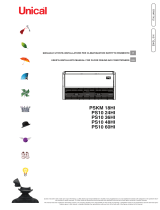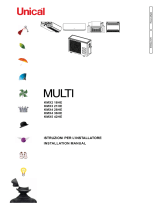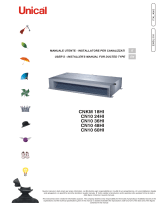Page is loading ...

MANUALE D’USO / USER MANUAL
Tecnosystemi S.p.A. - Società Benefit
www.tecnosystemi.com
via dell’Industria, 2/4 - Z.I. San Giacomo di Veglia
31029 Vittorio Veneto (Treviso) - Italy
Phone +39 0438.500044 Fax +39 0438.501516
Numero Verde 800 904474 (only for Italy)
email: [email protected]
C.F. - P. IVA - R.I.TV IT02535780247 | Cap. Soc. € 5.000.000,00 i.v.
REV. 02 / 25-08-2022
COD. CMU00028
KIT GRUPPO MANOMETRICO A 2 VIE CON PROTEZIONE IN
GOMMA PER R32 - R410A - R134 - TR422ABCD (R22) CON
FRUSTE, FORNITO IN VALIGETTA
2-WAY DRY PRESSURE GAUGE UNIT KIT WITH RUBBER PROTECTION FOR R32 -
R410A - R134 - TR422ABCD (R22) WITH HOSES, SUPPLIED IN A CARRYING CASE
• cod. TSC200004
GRUPPO MANOMETRICO A SECCO 2 VIE CON PROTEZIONE
IN GOMMA PER GAS R32 - R410A - R134 - TR422ABCD (R22)
2-WAY DRY PRESSURE GAUGE UNIT HIGH/LOW PRESSURE FOR GAS R32 -
R410A - R134 - TR422ABCD (R22)
• cod. TSC200005

2
1 - COMPONENTI E SPECIFICHE
/ 1 - PARTS AND SPECIFICATIONS
N. Nome / Name N. / NO. Nome / Name
1 Gancio / Hook 9Manometro bassa pressione
/ Low Pressure gauge
2Manometro alta pressione
/ Hi Pressure gauge 10 Guaina / Sheath
3 Coperchio / Cap 11* Tubo blu / Blue hose
4Vite regolazione zero
/ Zero adjusting screw 12* Tubo giallo / Yellow hose
5Valvola alta pressione
/ High pressure valve 13* Tubo rosso / Red hose
6 Visore / Sight glass
7Valvola bassa pressione
/ Low pressure valve
8 Attacco / Connection
*
* SOLO PER CODICE TSC200004
* ONLY FOR CODE TSC200004

3
2 - PARAMETRI TECNICI
/ 2 - TECHNICAL PARAMETER
N. elemento
/ Item No.
Diametro
manometro
/ Gauge
Diameter
Classe
mano-
metro
/ Gauge
Class
Pressione
Scala
/ Pressure
Scale
Accessori
collettore
/ Manifold
fittings
Tubo / Hose
per modello
R32 e R410
For model
R32 - R410
68 mm 1,6 -30-500psi 1/4”
Rosso e blu: 5/16”, 2x120 cm
Giallo: 1/4”, 1x120 cm
Red and blu: 5/16”, 2x120 cm
Yellow: 1/4”, 1x120 cm
3 - ISTRUZIONI PER L’USO
/ 3 - OPERATING ISTRUCTION
4.1 TEST DI PRESSIONE
4.1.1 Collegare il tubo blu sul lato inferiore del sistema, collegare il tubo rosso sul lato superiore del
sistema.
4.1.2 Collegare il tubo blu sul lato inferiore del sistema, collegare il tubo rosso sul lato superiore del
sistema.
4.1.3 Avviare il sistema, leggere la pressione di prova indicata sul manometro a collettore.
4.1.4 Effettuata la prova, spegnere il sistema. Scollegare quindi i tubi dal sistema e aprire tutte le valvole,
verificando che il refrigerante non si disperda in atmosfera.
4.1.5 Per poter evitare la dispersione del refrigerante in atmosfera, utilizzare una macchine di recupero/
riciclo che permetta di scaricare il refrigerante residuo nel tubo o nel manometro a collettore.
4.2 EVACUAZIONE DI UN SISTEMA
4.2.1 Collegare il tubo blu sul lato inferiore del sistema, collegare il tubo rosso sul lato superiore del
sistema, quindi collegare il tubo giallo sulla pompa a vuoto.
4.2.2 Aprire entrambe le valvole.
4.2.3 Aprire la pompa a vuoto.
4.2.4 Controllare la pressione sul manometro bassa pressione, per 3 - 5 minuti, verificando che il vuoto
abbia raggiunto e chiuso entrambe le valvole; chiudere quindi la pompa del vuoto.
4.2.5 Osservare la pressione sul manometro bassa pressione, se la lancetta è ferma su “- 1” tra 3 e 5
minuti, l'evacuazione dal sistema è avvenuta correttamente. In caso contrario, ripetere i passaggi da 4.2.2
a 4.2.4.
4.3 RIEMPIMENTO DI UN SISTEMA DOPO L’EVACUAZIONE
4.3.1 Tenere chiuse tutte le valvole. Scollegare il tubo giallo dalla pompa del vuoto e collegarlo al
contenitore di refrigerante.
4.3.2 Aprire la valvola sul contenitore di refrigerante.
4.3.3 Aprire le valvole ad alta/bassa pressione. Il sistema viene ora riempito di refrigerante. Se il flusso
di refrigerante è troppo lento o insufficiente, il compressore dell’unità può essere acceso (idoneo per
refrigerante r134a) per accelerare il processo.
4.3.4 Se è stata raggiunta la corretta quantità di riempimento, chiudere tutte le valvole.

4
4.3.5 Effettuata la prova, spegnere il sistema. Scollegare quindi i tubi dal sistema e aprire tutte le valvole,
verificando che il refrigerante non si disperda in atmosfera.
4.3.6 Per poter evitare la dispersione del refrigerante in atmosfera, utilizzare una macchine di recupero/
riciclo che permetta di scaricare il refrigerante residuo nel tubo o nel manometro a collettore.
4.3.7 I manometri a collettore sono strumenti di misurazione ad alta precisione. Dopo l’uso, conservare
sempre il manometro a collettore nella custodia trasportabile.
4.1 PRESSURE TESTING
4.1.1 Connect blue hose to the low side of system, connect red hose to the high side of system.
4.1.2 Connect blue hose to the low side of system, connect red hose to the high side of system.
4.1.3 Running the system, read the testing pressure indicated on manifold gauges.
4.1.4 After testing, turn off the system. Then disconnect the hoses from the system and open all valves, make
sure do not vent refrigerant into the atmosphere.
4.1.5 In arder to prevent venting the refrigerant ìnto the atmosphere please use a recovery/recycling machine to
evacuate any refrigerant remaining in the hose or manifold gauges.
4.2 EVACUATION OF A SYSTEM
4.2.1 Connect blue hose to the low side of system, connect red hose to the high side of system and connect
yellow hose to vacuum pump.
4.2.2 Open both valves.
4.2.3 Turn on the vacuum pump.
4.2.4 Check pressure on low pressure gauge far 3 to 5 minutes, if vacuum reached closed both vales then turn
of the vacuum pump.
4.2.5 Observe the pressure on the low pressure gauge if the pointer is stick to “- 1” far 3 to 5 minutes, the
evacuation of a system is succeed. lf not, repeat the steps from 4.2.2 to 4.2.4.
4.3 FILLING OF A SYSTEM AFTER EVACUATION
4.3.1 Keep all valves closed. Disconnect the yellow hose from the vacuum pump and connect this hose to a
refrigerant container.
4.3.2 Open valve on refrigerant container.
4.3.3 Open high/low pressure valves. The system is now being filled with refrigerant. If the flow of the refrigerant
is too slow or insufficient the compressor of the unit can be turned on (suit for r134a refrigerant) to speed up
the process.
4.3.4 If the correct filling quantity has been reached close all valves.
4.3.5 After testing, turn off the system. Then disconnect the hoses from the system and open all valves and then
make sure do not vent refrigerant into the atmosphere.
4.3.6 In order to prevent venting the refrigerant into the atmosphere please use a recovery /recycing machine to
evacuate any refrigerant remaining in the hoses or manifold gauges.
4.3.7 Manifold gauges are high precision measuring instruments. After use, store the manifold gauges always
in the carrying case.
4.4 EVACUATION AND FILLING FOR THE AUTOMOTIVE AIR CONDITIONER.
(ONLY SUITABLE FOR MG-2-R134A)
4.4.1 Please connect the blue hose to the blue quick coupling, red hose to the red quick coupling, yellow hose to
the vacuum pump intake port.
4.4.2 Quick coupling should be insert to automotive air conditioner connector’s connector correspondingly, and
then open the valve.
4.4.3 Please refer to “4.2.2 to 4.3.7” about the operating istruction
4.4.4 Before remove the quick coupling, please make sure that all the valves are closed.

5
5.1.1 Please do not overexert when switching valves.
5.1.2 Manifold are high precision measuring istruments. After use, store manifold gauges always in the carrying case.
1.1 The manifold has been designed especially to measure pressure in refrigeration equipment. The manifold may
only be used by trained technicians.
1.2 The manifold must not be used for other than refrigeration applications in connection with refrigerants. The
manifold is not suitable for other liquids or gases than those indicated on the gauge.
1.3 The manifold must not be used with pressures higher than the pressure scale indicated on the high presure gauge
of the manifold.
1.4 Safe goggles and gloves must be worn at all time during the use of the manifold.
1.5 The gauges are correctly calibrated at the factory before shipment. If calibration is required, remove the lens by
4 - MANUTENZIONE
/ 4 - MAINTENANCE
5 - GUIDA PER LA SICUREZZA
/ 5 - SAFETY GUIDE
5.1.1 Non sforzare troppo nel ruotare le valvole.
5.1.2 I collettori sono strumenti di misurazione ad alta precisione. Dopo l’uso, conservare i manometri a
collettori nella custodia trasportabile.
1.1 Il collettore è stato progettato specificamente per misurare la pressione nelle apparecchiature di
refrigerazione. Il collettore può essere utilizzato solo da tecnici idoneamente formati.
1.2 Il collettore non deve essere utilizzato se non per applicazioni di refrigerazione, relativamente ai refrigeranti.
Il collettore non è idoneo per altri liquidi o gas rispetto a quanto indicato sul manometro.
1.3 Il collettore non deve essere utilizzato con pressioni superiori rispetto a quanto indicato sul manometro
ad alta pressione del collettore.
1.4 Indossare sempre i guanti e gli occhiali di sicurezza durante l’uso del collettore.
1.5 I manometri sono calibrati correttamente in fabbrica prima della spedizione. Se è necessaria la calibrazione,
rimuovere le lenti, dopo aver rimosso la lunetta. Inserire un cacciavite a punta dritta nella vite di regolazione
sulla parte anteriore del manometro.
1.6 Pulire le interfacce di collegamento per evitare l’ingresso di sostanze contaminanti nel sistema di
refrigerazione.
1.7 Controllare i tubi di carica e pulire rimuovendo i residui di olio prima di ogni uso. Inoltre, è necessario un
controllo visivo per accertarsi che i tubi e i collegamenti siano intatti e serrati.
1.8 Non inserire direttamente il refrigerante, in quanto può causare lesioni personali.
1.9 Non disperda in atmosfera il refrigerante.
1.10 Le tenute e le guarnizioni del manometro sono componenti integranti del sistema e devono quindi essere
sostituiti di tanto in tanto. Il collettore deve essere testato regolarmente, per accertarsi che le valvole siano
ancora ben serrate.
1.11 Accertarsi di utilizzare il manometro con la pressione giusta.
1.12 I collettori sono strumenti di misurazione ad alta precisione. Dopo l’uso, scollegare tutti i tubi dal sistema
e aprire le valvole; conservare quindi il collettore sempre nella custodia trasportabile.
1.13 Smaltire il manometro a collettore attenendosi alle norme e regolamenti in vigore presso il Paese di
utilizzo.

6
first removing the bezel. Insert a straight blade screwdriver into the adjusting screw on the gauge face.
1.6 Cleanup the connection interfaces in order to prevent contamination entering to refrigeration system.
1.7 The charging hoses must be checked and clean of oil residue before each use. A visible control is also necessary
to ensure that the hoses and the connection are undamaged and tight.
1.8 Do not connector refrigerant directly it may cause personal injury.
1.9 Do not vent refrigerant into the atmosphere.
1.10 The seals and gaskets of the manifold gauge are parts of use and must therefore be replaced from time to time.
The manifold is tobe tested regularly to ensure the valves are still tight.
1.11 Make sure to use the right pressure gauge.
1.12 Manifolds are high precision measuring instruments. After use, disconnect all hoses from the system and open
valves and then store the manifold always in the carrying case.
1.13 Dispose of the manifold gauges according to the rules and regulations of the country of use.

7
SMALTIMENTO
DISPOSAL
GARANZIA
WARRANTY
Alla fine della sua vita utile il prodotto non deve essere smaltito insieme ai rifiuti urbani. Può essere
consegnato presso gli appositi centri di raccolta differenziata predisposti dalle amministrazioni
comunali, oppure presso i rivenditori che forniscono questo servizio. Per rimarcare l’obbligo di smaltire
separatamente gli elettrodomestici, sul prodotto è riportato il marchio del contenitore di spazzatura
mobile barrato.
At the end of its useful life, the product must not be disposed of with household waste. It can be deposited at
a dedicated recycling centre run by local councils, or at retailers who provide such a service. To highlight the
requirement to dispose of household electrical items separately, there is a crossed-out waste paper basket
symbol on the product.
La garanzia ha durata di 1 (uno) anno a decorrere dalla data di consegna indicata sul d.d.t (bolla). E’ prevista altresì
l’estensione d’ufficio, a titolo gratuito, per il secondo anno (due anni complessivi di garanzia) con decorrenza sempre
dalla data indicata nel d.d.t di consegna (bolla).
L’azienda fornitrice garantisce la qualità dei materiali impiegati e la corretta realizzazione dei componenti. La garanzia
copre difetti di materiale e di fabbricazione e si intende relativa alla fornitura dei pezzi in sostituzione di qualsiasi
componente che presenti difetti, senza che possa venir reclamata alcuna indennità, interesse o richiesta di danni.
La garanzia non copre la sostituzione dei componenti che risultano danneggiati per:
• trasporto non idoneo;
• installazione non conforme a quanto specificato in questo manuale di installazione uso e manutenzione;
• la non osservanza delle specifiche tecniche di prodotto;
• quant’altro non riconducibile a vizi originari del materiale o di produzione a condizione che il reclamo del cliente
sia coperto dalla garanzia e notificato nei termini e modalità richiesta dal fornitore, lo stesso si impegnerà, a sua
discrezione, a sostituire o riparare ciascun prodotto o le parti di questo che presentino vizi o difetti.
The warranty is valid for 2 (two) years from the delivery date indicated on the delivery note / waybill.
The supplier company guarantees the quality of the materials used and the correct construction of the components. The
warranty covers defects in materials and manufacturing defects and refers to the supply of spare parts of any components
featuring defects, without any compensation, interest or claim for damages.
The warranty does not cover the replacement of components damaged due to:
incorrect transportation;
installation not compliant with that specified in this installation, use and maintenance manual;
non-observance of product technical specifications;
Anything else that is not linked to original faults of the material or production provided that the
customer complaint is covered by the guarantee and a claim is made within the time limit and
in the way requested by the supplier, the same supplier will commit, at their own discretion,
to replace or repair any product or part of product showing signs of faults or defects.

·
W
E
A
R
E
A
B
E
N
E
F
I
T
C
O
M
P
A
N
Y
·
W
E
A
R
E
A
B
E
N
E
F
I
T
C
O
M
P
A
N
Y
·
W
E
A
R
E
A
B
E
N
E
F
I
T
C
O
M
P
A
N
Y
Tecnosystemi S.p.A. Società Benefit
www.tecnosystemi.com
via dell’Industria, 2/4 - Z.I. San Giacomo di Veglia
31029 Vittorio Veneto (Treviso) - Italia
Tel +39 0438.500044 - Fax +39 0438.501516
email: [email protected]
C.F. - P. IVA - R.I.TV IT02535780247
Cap. Soc. € 5.000.000,00 i.v.
800 904474
ONLY FOR ITALY
WATCH OUR
INSTITUTIONAL VIDEO
II
SS
OO
9
9
0
0
0
0
1
1
S
S
Y
Y
S
S
T
T
E
E
MM
CC
EE
RR
TT
II
FF
II
C
C
A
A
T
T
I
I
O
O
N
N
/







